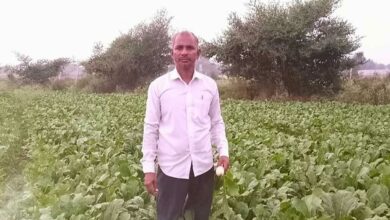This farmer of Haryana did wonders by cultivating sweet corn; now he is earning a lot
Cultivation of Sweet Corn: Ramesh Chauhan is a resident of the Haryana district of Palwal. In 1978, he began farming and farmed traditional crops that are widespread in Haryana, such as sugarcane and paddy. Although he was earning a consistent income from these crops, it was never enough to satisfy his dreams of a better life for his family and himself. Ramesh remembers those early years and says, “I worked tirelessly, season after season, but the profits were barely enough to cover the costs.”

Ramesh made his first big change in 1998. He took the risk of growing mentha, or Japanese mint, which is a more profitable crop. This audacious action was a positive step toward improving his income and self-assurance in making unorthodox choices.
Using Sweet Corn
Having grown sugarcane, paddy, and mentha for years, Ramesh started to notice changes in the agricultural market. Produce that was fresher, more varied, and healthier was becoming more and more in demand as consumer tastes changed.
Ramesh chose to switch to sweet corn because it was a commodity that could satisfy the rising demand in nearby markets, not merely because it was more profitable. Sweet corn is a favorite in both rural and urban settings due to its delicious flavor and high nutritional content. Ramesh viewed this as a chance to cultivate a crop that would provide higher yields and more rapid financial gain.
Ramesh says, “It was the best decision I ever made to switch to sweet corn.” “There is always a market for it, and the profits are much higher than what I was making from traditional crops.” Soon after, he focused on growing vegetables and sweet corn, as he believed that these crops could be swiftly harvested and sold for a profit.
Smooth Transition to Sweet Corn
After concentrating only on sweet corn for the last two years, Ramesh now farms four acres of vegetables in addition to sweet corn. By utilizing the same area to produce wheat in the off-season, his creative farming methods enable him to harvest delicious corn twice a year. Ramesh is now thinking about switching from wheat to butternut squash and cucumber, which both sell for more money per kilogram—between Rs. 800 and Rs. 1,000—and don’t need any extra precautions. “I want to use my property to its full potential. He explains resolutely, “I now consider maximizing rewards and decreasing work in every move I make.
Demand and Growth in the Market
Ramesh’s choice to grow sweet corn has created new prospects and allowed him to access markets outside of his little community. He remembers his first experience selling vegetables in Azadpur Mandi, one of India’s biggest wholesale marketplaces. “I recall my first visit to Azadpur Mandi with my sweet corn. Ramesh remembers with a smile that “the demand was overwhelming.” “It sold out within minutes, and that’s when I knew I was onto something big.”
In Palwal Mandi, Ramesh’s daily sales were typically between two and two and a half quintals the previous year. These numbers have now increased to eight or ten quintals every day, and the demand is still growing. He still can’t believe how much his company has expanded. “I bring five quintals of sweet corn to the market every day, and it sells out within 20 to 25 minutes,” he says. Sweet corn is more than simply a crop to Ramesh; it’s the cornerstone of a brand-new existence full of prospects for advancement and financial security.
Analysis of Cost and Profit
Ramesh says sweet corn’s excellent profit margins and affordability set it apart from other commodities. He discloses that he makes around Rs. 1 lakh in 70 days selling sweet corn for Rs. 15 per kilogram. With production expenses of around Rs. 20,000 per acre, he may make a profit in less than two months of between Rs. 75,000 and Rs. 80,000. “The numbers speak for themselves,” he asserts confidently. “I’m earning four times more than what I used to with traditional crops.”

Ramesh recently sold delicious maize that was cultivated on barely half an acre and made Rs. 80,000. He believes he might make up to Rs. 1.5 lakhs per acre when market prices climb, which would make sweet corn one of his most successful harvests to date. With a proud tone, Ramesh says, “Every time I see those numbers go up, I feel like all the hard work and risks I’ve taken are finally paying off.”
Upcoming Plans
With an eye on the future, Ramesh is already preparing to grow his company. He is negotiating with a business that makes frozen food items. “They’ve told me about government subsidies for machinery that will help me pack and freeze sweet corn,” he beams. “If I can offer frozen sweet corn, I’ll be able to reach even more markets and extend the shelf life of my produce.”
Ramesh is optimistic that his farm will expand and bring him even more prospects and earnings with these objectives in mind. With a hopeful tone, he says, “I want to create something lasting, something that my children can take forward.”
Appreciation and Honors
Ramesh’s diligence has not gone unappreciated. He has won several honors for his services to agriculture throughout the years. Getting the Progressive Farmer Award and a Rs. 51,000 reward from Gujarat Chief Minister and Prime Minister Narendra Modi was one of his happiest memories. With joy, Ramesh said, “Getting that award from Modi Ji was one of the most memorable days of my life.” Additionally, former Haryana Chief Minister Bhupendra Hooda has twice given him the Progressive Farmer Award.
In the Direction of Organic Farming
Ramesh is thinking forward and considering sustainability as well. Despite the difficulties involved, he is progressively switching to organic farming. Ramesh says, “Organic farming is the future.” “But the market for organic products in India is still developing.” He makes the argument that yields of sweet corn grown organically are less—roughly 30 quintals per acre as opposed to 70 quintals produced by chemical farming. For Ramesh, however, the transition is beneficial because of the long-term advantages of sustainable farming. “I want to farm in a way that protects the soil, the environment, and the health of the people who eat my produce,” he says with intent.
Ramesh shows via his narrative that success in agriculture is not only attainable but also inevitable for those who possess these qualities—hard effort, perseverance, and the capacity to change.





